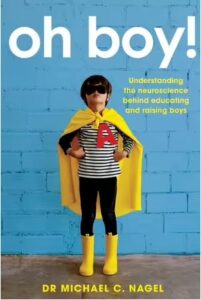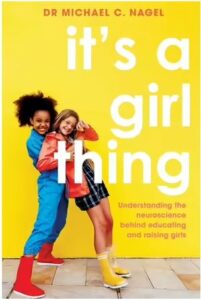Reading and the Brain

What’s really going on in the head of a boy? What can science tell us about educating and raising boys? How wonderful to share this article from a fellow dedicated boy champion, Professor Michael Nagel. Professor Nagel and I have had many conversations around boys, how best to engage them, the influences of technology, adolescence and how we can educate them in the best possible way. Parents and educators, read this article which gives us a close look at the male brain – how it develops – and the crucial role it plays in how a boy thinks and learns.
Reading and the Brain
Throughout my career as an educator, academic and researcher I have found one of the most timeless and challenging aspects of the parenting and teaching of boys is that of literacy development. Under that umbrella is the challenge of getting boys to read! In this short article I would like to share with you some important insights regarding reading and the brain, boys and reading and some key points for engaging boys in reading and by association literacy.
To begin, it is worth noting that literacy is a fairly modern convention and loosely refers to a person’s ability to read and write. Speaking, on the other hand, has developed over tens of thousands of years, and because it is so instinctive we don’t have to teach children how to talk. Reading, on the other hand is an extremely recent cultural activity with the alphabet being only 4,000 years old. In the history of humanity, and until recently, only a very small fraction of people could read and write. Today, reading is often taken for granted as something all people do to some degree without little consideration that learning to read is a major challenge and event in a child’s life. Indeed, when we look at the brains of educated adults we can actually see circuitry that is specialised for reading. This circuitry is not evident in young children and needs time and practice to develop. Let me repeat that, it takes time (especially for boys) and practice. Allow me to explain why!
First, let’s explore aspects of time in relation to regions of the brain involved in language and reading, and brain maturation by starting with oral language. It is well established through decades of research that when children arrive at school for the first time, reading and writing are not precursors for success. Oral language is a different story. In fact oral language ability is fundamental to literacy development and by association school success. In other words, a child with good oral language skills will, on average, do well early in school and as the school years pass will also perform well as subjects incorporate greater vocabulary and demands on comprehension. It should go without saying that many variables can impede such progress, but in terms of literacy development you want your child to talk and talk and talk…the spoken word facilitates the development of processes in the brain for engaging in reading and writing. This is why oral language development is such an important precursor to all aspects of literacy and should be encouraged whenever possible. There is, however, a slight challenge for this with boys.
Have you ever wondered why, by almost all measures, girls outperform boys in all aspects of literacy. It turns out that regions of the brain responsible for oral language mature earlier in females than in males and can do so by as much as 18-24 months. It is not uncommon to observe three year old girls with similar oral proficiency as their five year old male siblings. This early imbalance tends to wane somewhere between 6 to 8 years of age and is one reason why some Scandinavian countries do not start engaging children in aspects of literacy instruction in the early years of schooling. This doesn’t mean that boys will necessarily flounder but it does suggest that expectations around reading and writing need to be tempered with an understanding that the best thing for all children in the early years, especially boys, is lots of discussion, probing and asking of questions. Significantly, oral language development can be enhanced when children are frequently read to or share in the exploration of reading materials with parents and caregivers. When you read the text on a cereal box in the morning with your children, you are modelling good literate practices, engaging your child in oral language and doing so in a way that need not seem like a literacy lesson.
Second, and most important to this conversation, reading takes practice and lots of it! While oral language comes naturally to all children across all cultures, reading does not. As alluded to earlier, the circuitry of the brain that allows us to read needs to be developed. Reading is a highly complex cognitive skill requiring the brain to organise, integrate and extract meaning from words and sentences. A reader needs to map the sounds of the language onto letters and then decode the letters and sounds to form words culminating in the need to understand the meanings of the words and how they fit together to comprehend sentences. Different brain areas underlie each of these subskills and with time and practice the circuit board for reading develops with all the wiring in place to decipher the printed word. Practice means an incremental build-up of skills from learning the alphabet, to developing an understanding of sounds associated with letter combinations (phonics) to identifying progressively more complex words, to putting words together in sentences. These skills also link with the development of spelling and grammar and do not happen simply by being immersed in an environment with vocabulary and books at ones disposal. Learning to read and write is effortful and requires skilful instruction, especially for boys.
The last couple of sentences above, oddly, can be controversial. This is due to a lingering legacy of ‘whole-language’ advocates who focus on the meaning of words presented in texts and suggest that teachers provide a literacy rich environment for their students combining speaking, listening, reading and writing. In a whole language approach students are taught to use critical thinking strategies and use context to guess words that they do not recognize. I would posit that this approach puts the proverbial cart before the horse. Given that critical thinking and most higher order thinking skills take years to develop and that some sense of any letter/sound relationship is necessary for recognising words, the environment is secondary to direct instruction incorporating phonics in ‘a literacy rich environment’. It is not one or the other, but one before the other in terms of efficacy and building the neuro-circuitry for reading. From an understanding of letters to sounds to words to sentences the reading circuitry of the brain can be unfurled and engaged in an environment where reading is modelled.
In the end, boys require a range of approaches, including phonics and reading opportunities that use the natural-style language of ‘real’ books that are of interest. There is plenty of evidence to suggest that boys appear to do better in all aspects of literacy when direct instruction is supported by approaches and materials that are interesting to boys. In an educational context it is also important for any formal language and literacy teaching to incorporate significant opportunities for boys to focus on activities that are relevant and meaningful to them. Reading materials should contain structures and subject matter of interest to boys and this is even more pertinent in the teenage years when boys often disengage due to a lack of interest in prescribed texts. It is also significant for teachers to bear in mind that allowing boys to explore literacy at a pace that suits their ability is particularly important; in the early years of schooling boys will not be reading at the same pace as girls. Frustration and a feeling of failure must be avoided at all costs. In the eyes of a boy, there is nothing more likely to shut down experiences in literacy than appearing inadequate in front of his peers. When a boy struggles and stumbles with some text, it should be apparent that he is attempting to engage at a level he is not ready for and an alternative must be offered. When he disengages, it could simply be that he is bored or uninterested. Another truism with boys is that unlike many girls, boys are not always driven to please the teacher and acquiesce to doing something that they have little interest in or incapable of; better to be the class clown than appear the village idiot.
Outside of the school environment it is monumentally important for parents to remember that reading and all aspects of literacy development begin long before a boy enters school and develops as each year progresses. This means that reading should be modelled, especially by males. It is important for boys to see males reading and to have older males read to them given that many boys believe reading and books are feminine pursuits or something that girls do. Given the environment is so significant in shaping a boy’s neural architecture, parents and caregivers must also demonstrate that they value engaging in reading and offer opportunities for boys to do likewise. A reading environment would encapsulate books, magazines, comics or good online resources. In the end, practice makes perfect and any opportunity that engages boys in reading can only lead to positive results in school and life.
For extra resources in this area, I can highly recommend the following:


We are incredibly passionate about improving kids’ literacy – research consistently supports the fact that confident readers achieve more highly than disengaged learners. If you are wanting a resource that can boost your child’s literacy leading into 2022, please visit Literacy for Boys or Literacy for Kids
Check out our recent appearance on Channel 7 News ~
Parents ~ sign up for a free 30-day trial and improve your son’s literacy for the upcoming school year!
As an educator, do you want more from your literacy program? Contact us for a 30-day free trial in your school or classroom. Sign up for our newsletter and get FREE Comprehension Worksheets for Years 3 to 9.
Check out our blogs for more ideas and tips.
Steps to Successfully Support Disengaged Learners
See us featured in The Educator Australia magazine
Research confirms that early reading boosts literacy
Boys Love LFB – Here’s what they have to say!
Get boys reading in the digital age
Why write? Tips for reluctant writers
Brought to you by Tanya Grambower

